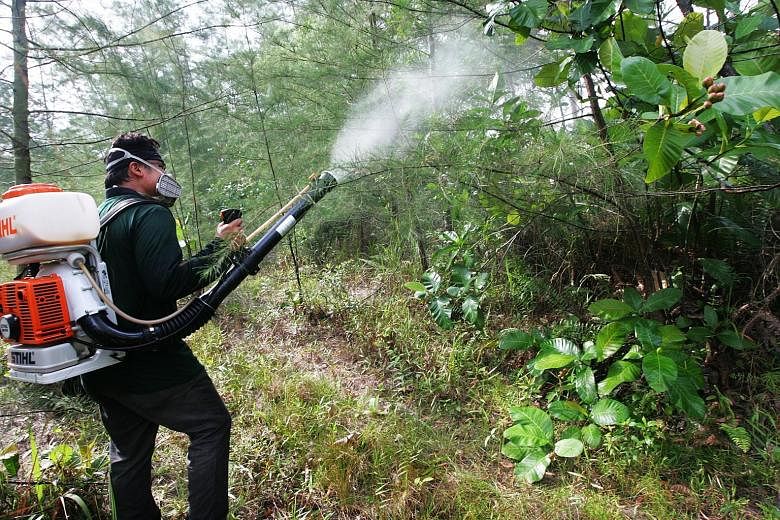Despite low case numbers, Singapore remains guarded against the threat of malaria.
The nation was declared malaria-free by the World Health Organisation in 1982, after battling many outbreaks and thousands of deaths from the mosquito-borne disease since the early 1900s.
After decades of intensive control measures that included spraying the surfaces of workers' quarters with insecticide and closely tracking transmission, the disease was eradicated in the 1980s.
Still, between 2016 and 2019, there were close to 40 cases a year, and almost all were imported.
Malaria is mainly transmitted through the bite of a female Anopheles mosquito, which can carry the parasite.
Considered a "rural" mosquito, the Anopheles is found mainly in Singapore's coastal areas and marshes, as well as forested places with still water, said Associate Professor Kevin Tan, head of the microbiology and immunology department at the NUS Yong Loo Lin School of Medicine.
He and other researchers at the school spoke to The Straits Times as it marked World Malaria Day last month.
Assistant Professor Benoit Malleret, from NUS Medicine's department of microbiology and immunology, said: "The mosquito vector is present in Singapore, and if anyone comes into the country carrying the parasite and is undetected, you could possibly have an outbreak (here)."
However, the chances of this happening are quite low, and the country has had no significant outbreaks in the last decade, he added.
Strict surveillance is in place, from doctors being required to notify the Ministry of Health (MOH) of cases within 24 hours of diagnosis to compulsory screening for foreign workers.
-
40
Approximate number of cases per year between 2016 and 2019; almost all the cases were imported.
According to MOH data in 2019, foreign workers made up 44 per cent of the more than 1,200 imported cases from the past decade.
Some dorms and worksites were near places conducive to the survival of Anopheles mosquitoes.
Some cases can slip past surveillance as malaria parasites can be crafty. For instance, the Plasmodium vivax (P. vivax) parasite - the most prevalent strain in Asia - can stay hidden in a person's liver for months undetected after recovery from malaria, until it causes a relapse.
An Anopheles mosquito could become infected if it bites the person, and could go on to infect other people it bites, said Prof Tan.
The last documented malaria clusters here in 2009 were in Mandai-Sungei Kadut, Jurong Island and Sembawang, and involved 29 foreign workers and residents who had not recently travelled abroad.
Although the causes of transmission are uncertain till now, one possibility could be the relapse of P. vivax malaria among some of the cases, said Prof Tan.
However, experts stressed that the chances of having full-blown, uncontrollable local outbreaks are low, as the National Environment Agency (NEA) has an Anopheles mosquito vector surveillance and control programme.
Whenever breeding sites are detected, it will carry out larvicidal oiling and spraying with insecticides, as well as intensive thermal fogging and residual spraying to kill adult mosquitoes.
Dr Ch'ng Jun Hong, a lecturer in the same department at NUS Medicine, said: "If there are known urban hot spots for mosquito breeding, whether Aedes or Anopheles, those areas would have been tackled already as part of dengue control, so you kill two birds with one stone in those efforts.
"If there are no parasites in our human populations, and it's a very restricted vector population, the risk of a local infection is very low."
THE SIMIAN CONNECTION
In 2007 and 2008, six soldiers who trained at a forested area in the Western Water Catchment area came down with malaria.
They were found to be infected with Plasmodium knowlesi - a malaria parasite that is found in monkeys. These were Singapore's first cases of monkey malaria.
After spending almost a decade testing more than 370 wild long-tailed macaques deep in the forests and 660 macaques from the forest fringes and near urban areas, a study revealed that 80 per cent of the wild macaques carried malaria.
The 660 macaques living near urban areas and closer to people were malaria-free, according to the findings of a study published this year in the PLOS Neglected Tropical Diseases journal.
The study was done by researchers from organisations including NEA, NUS and the Singapore Armed Forces.
The infected wild macaques came from the forested areas within the military protected zone in the Western Catchment area.
Although numerous military personnel have trained at the zone in 2007 and 2008, only a handful acquired monkey malaria.
Since 2008, there has not been any reported local monkey malaria case in Singapore, following implementation of stricter controls.
Fortunately, the monkey parasite is not efficiently spread to humans, said Dr Ch'ng.
The paper concluded that there is a low risk of monkey-to-human malaria transmission to the general population here, but the possibility of the wild macaques emigrating from the military zone cannot be ignored.


